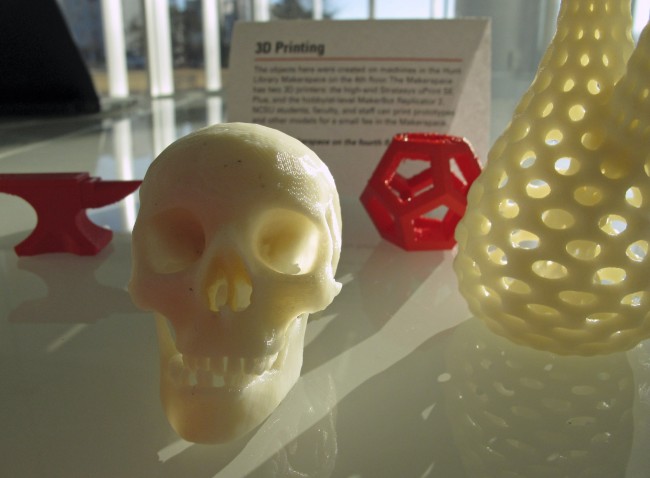No, We’re Not All Going To Get 3D Printers At Home

Tiny objects produced by a 3D printer sit on a table at the newly opened James B. Hunt Jr. Library at North Carolina State University in Raleigh on Friday, Jan. 4, 2013. The printer, an automated book retrieval system and walls that double as video screens are among the many innovations in the new, state-of-the-art facility.
GIVEN that some businesses are now successfully using 3 D printers there’s a bit of technophile crowing that the whole world is about to change. That we’ll all have one at home, producing anything and everything we want, and we’ll finally be clear of this capitalism shite and live forever in peace and harmony.
It’s true that certain businesses are indeed using them successfully:
British defence giant BAE Systems has become the latest company to take advantage of 3D printing technology to help manufacture components for fighter planes.
The company said on Sunday that a Tornado fighter jet fitted with parts that were printed in a machine, completed a successful test flight, potentially paving the way for the wider use of the technique in other manufacturing processes. The flight is significant as it is claimed to be the first made by a combat aircraft fitted with such parts.
Many experts are predicting that 3D printing will transform manufacturing and reduce the cost of making a range of products from advanced technology to plastic toys, with consumers able to make their own products at home on demand.
But there’s a very specific reason why this is successful. Two in fact.
The first is that this is a fighter plane. The sort of thing that we want to be available whenever and everyever. They’ve simply got to be able to fly when we need them. So, there’s a vast store of spare parts for them. You can, just about, go into an RAF parts store and build several new airplanes out of the stuff they’ve got sitting there just in case. What the 3D printer means is that you can have fewer of these vastly expensive parts sitting around just in case and instead have the designs and your printers. Need a part? Great, make one.
The second is that the traditional method of making these sorts of parts is so time consuming. You make the tools (the jig perhaps, or mold for other things) to make the part first, then you make the part and this takes months in and of itself. So if you ever run out of your store of parts it takes months and months (no, really) to get more. Better to have the plans on your computer and use the printer to make them.
None of these things are really true about, say, a teapot. It’s still vastly cheaper to make these in bulk in a factory and ship them out to shops. There’s usually no pressing need for one, it doesn’t cost much to keep a few on shop shelves and it doesn’t take months and months to make a new one either.
3D printing will indeed become an important part of the economy. But not so much for printing the sort of stuff we all use at home. It’ll still be cheaper to make all of those things in factories. Where it will make great sense is in those factories themselves for certain products.
Posted: 7th, January 2014 | In: Money, Technology Comment | TrackBack | Permalink


